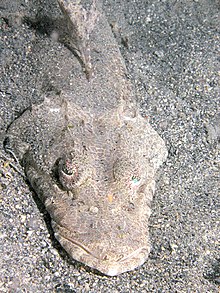Platycephalidae
| Platycephalidae | |
|---|---|

| |
Sunagocia otaitensis
| |
| Scientific classification | |
| Domain: | Eukaryota |
| Kingdom: | Animalia |
| Phylum: | Chordata |
| Class: | Actinopterygii |
| Order: | Scorpaeniformes |
| Suborder: | Platycephaloidei |
| Family: | Platycephalidae Swainson, 1839[1] |
| Genera[2] | |
The Platycephalidae are a family of marine fish, most commonly referred to as flatheads. They are relatives of the popular lionfish, belonging to the order Scorpaeniformes.
Taxonomy
Platycephalidae was first proposed as a family in 1839 by the English naturalist
Genera
Platycephalidae has the following genera classified within it:[2]
- Ambiserrula Imamura, 1996
- Cociella Whitley, 1940
- Cymbacephalus Fowler, 1938
- Elates D. S. Jordan & Seale, 1907
- Grammoplites Fowler, 1904
- Inegocia D. S. Jordan & W. F.Thompson, 1913
- Insidiator D. S. Jordan & Snyder, 1900
- Kumococius Matsubara& Ochiai, 1955
- Leviprora Whitley, 1931
- Onigocia D. S. Jordan & W. F. Thompson, 1913
- Papilloculiceps Fowler & Steinitz, 1956
- Platycephalus Bloch, 1795
- Ratabulus D. S. Jordan & Hubbs, 1925
- Rogadius D. S. Jordan & Richardson, 1908
- SolitasImamura, 1996
- Sunagocia Imamura, 2003
- Thysanophrys Ogilby, 1898
Platycephalidae has been divided into as many as 5
The genus
Etymology
The name of the family is derived from the Greek words platy, meaning "flat", and kephale for "head".[10]
Description
Platycephalids are small to medium-sized fish. Most species are small, reaching an average of 10 cm in length. However, a few species in the genus Platycephalus are known to grow up to over a 1 m (3 ft 3 in) in length.[11] Their most distinctive characteristic is the flattened shape of their heads. While the rest of their bodies is shaped similarly to other fish that inhabit the areas they frequent, their heads are triangle-shaped and dorsoventrally depressed, giving them the shape of a trowel or an artist's spatula.[12] Their eyes are situated on the upper surface, in accordance with their bottom-dwelling lifestyle. They possess two complete dorsal fins, the first one supported by six to 9 strong spines.
Distribution and habitat
Platycephalidae can be found naturally in coastal waters throughout the
Biology
Flatheads are mostly marine
Flatheads are
Fisheries
Active commercial fisheries are geared towards members of the family. In Japan, some species are the subject of experimental aquaculture programs. Flatheads are commonly caught on rod and line.[16] The larger species are considered game fish.
See also
References
- ^ PMID 25543675.
- ^ a b Eschmeyer, William N.; Fricke, Ron & van der Laan, Richard (eds.). "Genera in the family Platycephalidae". Catalog of Fishes. California Academy of Sciences. Retrieved 2 July 2022.
- ^ ISBN 978-1-118-34233-6.
- PMID 28683774.
- ^ Hisashi Inamura (1996). "Phylogeny of the Family Platycephalidae and Related Taxa (Pisces: Scorpaeniformes)". Species Diversity. 1: 123–233.
- .
- ^ Froese, Rainer and Pauly, Daniel, eds. (2022). Species of Sorsogona in FishBase. February 2022 version.
- ^ Eschmeyer, William N.; Fricke, Ron & van der Laan, Richard (eds.). "Genera in the family Platycephalidae". Catalog of Fishes. California Academy of Sciences. Retrieved 20 July 2020.
- ^ Eschmeyer, William N.; Fricke, Ron & van der Laan, Richard (eds.). "Species in the genus Sorsogona". Catalog of Fishes. California Academy of Sciences. Retrieved 20 July 2022.
- ^ Christopher Scharpf & Kenneth J. Lazara, eds. (7 December 2021). "Order Perciformes (Part 11): Suborder Platycephaloidei: Families Bembridae, Parabembridae, Hoplichthyidae, Platycephalidae and Plectrogeniidae". The ETYFish Project Fish Name Etymology Database. Christopher Scharpf and Kenneth J. Lazara. Retrieved 3 July 2022.
- PMID 25660779.
- ^ ISBN 0-12-547665-5.
- ^ Hussein C; Ibrahim A, Alshawy F; Ahmad AA (2021). "First confirmed record of the Bartail flathead Platycephalus indicus (L.; 1758) (Actinopterygii:Platycephalidae) in the Syrian marine waters (Eastern Mediterranean)". Species. 22 (69): 161–165.
- .
- )
- ^ Stewart, J (2015). "STATUS OF FISHERIES RESOURCES IN NSW 2013-14". NSW Fisheries Reports: 391. Retrieved 15 December 2017.
- "Platycephalidae". Integrated Taxonomic Information System. Retrieved 21 February 2007.
- Myers, P.; R. Espinosa; C. S. Parr; T. Jones; G. S. Hammond; T. A. Dewey (2006). "Platycephalidae". Animal Diversity Web. University of Michigan Museum of Zoology. Retrieved 2007-02-21.
External links
 Data related to Platycephalidae at Wikispecies
Data related to Platycephalidae at Wikispecies- Photos of several species of Crocodilefishes





